中考英语介词的用法讲解
中考初中英语复习语法知识讲解(介词的用法)

中考英语语法知识——介词的用法一、about的用法关于(某人或物)What is she worried about ?她在担心什么呢?在…… 各处;在……附近He looked about the hall,but saw nobody. 他环顾大厅,可是一个人也没看见。
目的是;为了;涉及……Movies are all about making money these days.当今电影全都是为了赚钱。
二、 above的用法意为“在……以上,高于;超过”(表示职位、数量、年龄等)He is the man above her.他是她的上司。
The stone weighs above one ton.这块石头重一吨多。
She is above fifty years old.她 50 多岁了。
意为“在……上方”(表示位置)The whole sky above us is filled with stars.我们上方的整片天空布满了星星。
三、 against的用法逆,顶着;靠着,倚靠;撞击(表示方向或位置)Birds fly slowly against the wind.鸟逆风飞得慢。
He stood with his back against the wall.他背靠墙站着。
The cold rain beat against the window.冷雨敲窗。
反对(与 for 意义相反) ;违背I don't know whether he is for or against it.我不知道他是赞成还是反对它。
防备,以防They have got prepared against flood.他们已经做好了防洪准备。
衬托Flowers look better against green leaves.好花还需绿叶衬。
与……比赛We'll be competing against some of the best companies in Europe.我们将要和欧洲的一些最好的公司竞争。
中考英语常用介词用法和固定搭配总结

中考英语常用介词用法和固定搭配总结常用介词用法和固定搭配总结:1. in –在一些位置或状态:in the park, in a hurry固定搭配:in front of, in the middle of, in the end2. on –表示在一些表面或接触点上:on the table, on the wall固定搭配:on foot, on the way, on duty3. at –在一些具体位置或时间点:at school, at 9 o'clock5. for –表示目的、目标或对象:study for the test, apresent for you固定搭配:wait for, thank you for, look for7. with –表示伴随、具备其中一种特征:go out with friends,a girl with long hair固定搭配:a conversation with, agree with, help with8. by –表示通过、凭借其中一种方式或手段:go to school by bus, learn by doing固定搭配:by the way, by accident, by oneself9. about –关于其中一主题、内容或事情:talk about the movie,a book about history固定搭配:think about, worry about, care about10. for –表示计划或安排事:get ready for the exam, prepare for a trip固定搭配:study for, wait for, ask for11. with –用于描述其中一种状态或情况:be happy with the result, be busy with work固定搭配:satisfied with, familiar with, pleased with12. about –表示具体细节或内容:talk about your trip, a movie about love固定搭配:worry about, think about, care about这些是常用的英语介词用法和一些固定搭配,但在实际运用中还需根据具体语境选择合适的介词。
中考英语常用介词用法和固定搭配总结

中考介词用法总结一、几个常用介词用法归纳(一)in的用法:1. 表示地点、位置。
意思为“在……之中,在……里面”,例如:(1)They often spend holidays in the country. 他们经常在乡下渡假。
(2)The children are playing in the yard. 孩子们在院子里玩耍。
常见搭配:in the school 在学校里;in the way 挡路;in the library在图书馆;in the bookcase 在书架中;in the park在公园;in the chair 在椅子中(扶手椅);in a car = by car 乘车;in the middle of 在……中间;in church去教堂做礼拜;in front of 在……前面(外部);in the church在教堂;in the front of 在……前面(内部);in the hospital在医院;in the wall 在墙内(镶嵌);in hospital在住院;in the tree 在树上(不表生长)be ill in bed卧病在床;in one’s hand 在某人手中;in this way 以这种方式;in the sun 阳光下;in the rain 在雨中;in the wind 在风中;in the sky 在天空中;in one’s dream 在梦中;in the newspaper 在报纸上;in the book 在书上;in my eyes 在我看来;be in 在家;2. 表示时间的范围。
意为“在……时候”,如:(3)He gets up at six in the morning. 他早晨6点起床。
(4)The Second World War ended in 1945. 第二次世界大战在1945年结束。
常见搭配:in winter 在冬天;in the middle of May 五月中旬;in the end 最后;in the future 在将来;in the past 在过去;in the middle of the day 在中午;in/over the last/past ten years在过去的十年中;3. 表示时间的经过。
中考英语介词用法归纳总结

中考英语介词用法归纳总结常用介词基本用法辨析表示方位的介词:in, to, on1. in表示在某地范围之内。
XXX China.上海在中国的东部。
2. to表示在某地范围之外。
Japan is/lies to the east of China.日本位于中国的东面。
3. on表示与某地相邻或接壤。
XXX位于中国北边。
表示计量的介词:at, for, by1. at表示“以……速度”“以……价格”。
It flies at about 900 XXX.它以每小时900公里的速度飞行。
I sold my car at a high price.我以高价出售了我的汽车。
2. for表示“用……交换,以……为价格”。
He sold his car for 500 dollars.他以五百元把车卖了。
注意:at表示单价(price),for表示总钱数。
3. by表示“以……计”,后跟怀抱单元。
They paid him by the month.他们按月给他计酬。
Here XXX.在这里鸡蛋是按重量卖的。
表示材料的介词:of, from, in1. of成品仍可看出原料。
This box is made of paper.这个盒子是纸做的。
2. from成品已看不出原料。
Wine is made from grapes.葡萄酒是葡萄酿成的。
3. in表示用某种材料或语言。
Please fill in the form in pencil first.请先用铅笔填写这个表格。
XXX.他们用英语交谈。
表示工具或手腕的介词:by, with, on1. by用某种方式,多用于交通。
I went there by bus.我坐公共汽车去那儿。
2. with表示“用某种工具”。
XXX.他用石头把玻璃砸坏了。
留意:with表示用某种工具时,必需用冠词或物主代词。
3. on表示“以……方式”,多用于固定词组。
XXX.他们通过电话进行交谈。
中考英语常用介词知识点总结

中考英语常用介词知识点总结一.表示时间的介词1. in, on, at在……(之时)①in与年、季节、月、年代、世纪及一般(泛指)的早、中、晚等较长时间的词连用eg:in summer在夏天;in January在1月;in 2012 在2012年;in the morning在早上in the 21st century②on用于具体的某日或某特定日期的早、中、晚。
如:on August 8th在8月8日;on Monday在星期一;on New Year’s Day;on a cold morning在一个寒冷的早晨;on Sunday afternoon在星期天下午。
③at表示某一时刻。
如:at 5∶10pm 在下午5∶10;at the beginning of在开始时;at the end of...在……的末尾;at the age of...在……岁时;at noon在中午;at the same time在同时。
at night在晚上;2. in, after 在……之后“in +时间段”用于将来时之中;“after+时间段”用于过去时态之中;“after+时间点”既可用于将来时也可用于过去时。
如:Jim will go to Beijing in five days.吉姆五天后会去北京。
Jim went to Beijing after five days.五天后,吉姆去了北京。
Jim will go to Beijing after five o’clock.吉姆会在五点钟后去北京。
3. for, sincefor可以指过去、现在或将来,着重说明“多久”,后面接时间段。
since意为“自从……起”,多与完成时连用,后面接时间点或从句。
since引导的从句通常为一般过去时。
如:He has lived here for 2 weeks./ He has lived here since 2 weeks ago.It’s five years since he left school.4. after, behind 在……之后after主要用于表示时间;behind主要用于表示位置。
中考介词冠词代词连词的用法总结
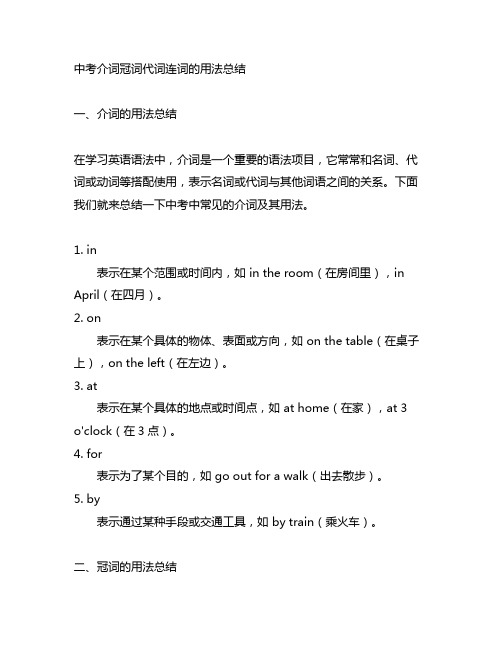
中考介词冠词代词连词的用法总结一、介词的用法总结在学习英语语法中,介词是一个重要的语法项目,它常常和名词、代词或动词等搭配使用,表示名词或代词与其他词语之间的关系。
下面我们就来总结一下中考中常见的介词及其用法。
1. in表示在某个范围或时间内,如 in the room(在房间里),in April(在四月)。
2. on表示在某个具体的物体、表面或方向,如 on the table(在桌子上),on the left(在左边)。
3. at表示在某个具体的地点或时间点,如 at home(在家),at 3 o'clock(在3点)。
4. for表示为了某个目的,如 go out for a walk(出去散步)。
5. by表示通过某种手段或交通工具,如 by train(乘火车)。
二、冠词的用法总结冠词是英语中一个比较难点的语法项目,分为定冠词“the”和不定冠词“a/an”。
下面我们来总结一下中考中常见的冠词用法。
1. 定冠词“the”表示特指,如 the sun(太阳)。
2. 不定冠词“a/an”表示泛指,如 a book(一本书)。
三、代词的用法总结代词是用来代替名词的词语,它能够减少重复,使语言更加简洁。
在中考中,代词也是一个重要的语法项目。
下面我们来总结一下中考中常见的代词及其用法。
1. 人称代词主格:I(我)、you(你)、he(他)、she(她)、it(它)、we(我们)、you(你们)、they(他们)。
宾格:me(我)、you(你)、him(他)、her(她)、it (它)、us(我们)、you(你们)、them(他们)。
形容词性:my/mine(我的)、your/yours(你的)、his(他的)、her/hers(她的)、its(它的)、our/ours(我们的)、your/yours(你们的)、their/theirs(他们的)。
2. 物主代词指代名词所有物,如 mine(我的)、yours(你的)、his(他的)、hers(她的)、its(它的)、ours(我们的)、yours(你们的)、theirs(他们的)。
01介词要点呈现与讲解中考英语一轮复习语法知识语篇能力双清(通用版)

3. We couldn’t finish our work so early _____ your help.
A. without B. with
C. for D. By
【解析】选A。句意:没有你的帮助我们不能这么早完成我 们的工作。without“没有”,是否定介词。
4. Shanghai Disneyland has started to be built and it will be open _____ five years.
3. 表示方式的常用介词
介词
用法
例句
1. by+表示交通工具的名词,
表示“乘……(交通工具)”
He goes to school by bike. 他骑自行车去上学。
by
2. by+ v.-ing形式,表示“通 He learns English by listening to the
过……方式”
With the help of him, I won the
game. 在他的帮助下,我赢得了比赛。
2. 表示“用”
Cut the bag with the knife. 用刀子割开这个包。
介词
用法
例句
What is your excuse about your
about
about多用于在内容和观点 上比较一般性的情况
介词 above over
用法
例句
表示“在……上方”,它表 The plane is flying high above the
示上下的位置关系,与 below相对
clouds. 飞机正飞翔在云彩之上。
表示“(垂直地)在…… A bridge is over the river.
中考英语介词的用法讲解

中考英语介词的用法讲解一、知识框架二、知识点梳理一、定义:介词:是一种用来表示词与词、词与句之间的关系的词,在句中不能单独作句子成分。
二、介词短语的句法作用1、介词短语相当于一个形容词或副词,可用作状语、定语和表语。
如:The man came <down the stairs>.(状)The woman <with a flower on her head> is from the countryside.(定)The teacher is now with the pupils.(表)(老师现在和学生在一起)2、介词短语在句子中的位置:介词短语做状语时,如果表示时间/地点,可以放在句首或句尾。
如果表示方向/方式/伴随/涉及/原因/目的/比较,一般放在句尾;介词短语作表语时放在连系动词之后;介词短语作定语时,只能放在被修饰的名词之后。
如:He wanted to find a good job in Shanghai the next year.(状语)They searched the room for the thief.The letters are for you.(表语)Have you seen a cat with a black head and four white legs?(定语)三、介词用法(一)表时间的介词:1.at通常用于:(表示在某个时刻或者瞬间)at+时间点,节日(泛指圣诞节、新年等整个假期时,要用at)如:at 7:30; at lunch time; at Christmas 在圣诞节期间固定词组搭配:at dawn, at night, at midnight, at noon, at that time, at the moment2. on通常用于:(表示在具体的某一天或者某天的上下午等)on+具体时间(日期,星期几)on October 1st ; on Monday; on a rainy morning; on Teachers’ Dayon Christmas Day 在圣诞节这一天3. in通常用于:(表示在一段时间里)①in+世纪/年/月/季节/早/中/晚in the 20th century, in the late 18th century②特定的年龄段,in his thirties (在他30多岁时)补充1:表示“在一段时间之后”,句子常用一般将来时。
by的用法归纳中考考点

by的用法归纳中考考点一、担任介词在中考英语中,"by"是一个常见的介词,有时表示动作的执行者或进行的方式等。
1. 表示动作的执行者例如:The book was written by Shakespeare.(这本书是莎士比亚写的。
)在这个句子中,“by Shakespeare”表示“莎士比亚”是执行该动作的人。
2. 表示进行的方式例如:She goes to school by bike.(她骑自行车去学校。
)在这个句子中,“by bike”表示“骑自行车”的方式。
二、表示时间和状态"by"可以用来表示某个特定时间之前完成某事,或者描述某种状态。
1. 表示特定时间之前完成例如:Please finish your homework by tomorrow morning.(请在明天早上之前完成你的作业。
)在这个句子中,“by tomorrow morning”表示要在明天早上之前完成动作。
2. 描述某种状态例如:I was surprised by the good news.(我被好消息惊讶到了。
)在这个句子中,“by the good news”表达了主语“我”的感受和状态。
三、标志被动语态"by"还可以用来标志被动语态中强调动作执行者。
例如:The cake was made by my mom for my birthday.(这个蛋糕是我妈妈为我的生日做的。
)在这个句子中,“by my mom”表明是“我妈妈”制作了蛋糕。
四、表示数量或程度"by"可以表示衡量部分或整体的数量或程度。
例如:He increased his score by 10 points.(他的分数增加了10分。
)在这个句子中,“by 10 points”表示分数增加了10个单位。
五、借由"by"也可以用来表示通过某种方式或工具来完成动作。
[全]中考初中英语考点详解:介词
![[全]中考初中英语考点详解:介词](https://img.taocdn.com/s3/m/8700c70002d8ce2f0066f5335a8102d276a261da.png)
中考初中英语考点详解:介词1.介词的分类及功能介词是一种用来表示词与词、词与句之间关系的词。
介词是虚词,一般不重读,不在句子中单独作成分,需要和它后面的词共同充当句子成分。
一介词的分类1根据介词的构成分类根据介词的构成形式,可将介词分为简单介词、合成介词、双重介词、短语介词四类。
(1)简单介词简单介词指的是由一个单词构成的介词。
Both my parents were born in 1970.我的父母都出生于1970年。
Whom are you taking the mobile phone to? 你要把这部手机带给谁?(2)合成介词合成介词指的是由两个词合在一起构成的介词。
He traveled throughout Europe in his twenties.在二十多岁时,他游历了整个欧洲。
I couldn’t see his face—he had his back towards me. (表示方向)我看不见他的脸——他背对着我。
(3)双重介词双重介词指的是由两个介词组成的介词。
I can take up to four people in my car.我的小汽车最多能坐4个人。
The moon finally appeared from behind the clouds.月亮终于从云后露了出来。
(4)短语介词短语介词由一个或几个简单介词和一个或几个其他词类组合构成,其作用只相当于一个介词。
Except for a broken bed,the room is empty.除了一张破旧的床,这个房间是空的。
Who are the boy and the girl in front of you?你前面的男孩和女孩是谁?提示短语介词是一个相当于简单介词的短语,不能单独使用,其后需加宾语。
而介词短语是由介词后加宾语构成,可以单独作句子成分。
2根据介词的意义分类根据介词的意义,可将介词分为表示时间的介词、表示空间(地点)的介词、表示原因(目的)的介词、表示让步的介词、表示方式(手段)的介词和其他介词。
中考必备介词的用法

The doctor will be with us ____insix minutes. We will meet again __i_n_ two weeks.
He received her letter __a_f_te_rfour weeks.
He will receiver her letter __a_f_t_er2 o’clock.
crowd. the window.
He studied the sky _______t_h_r_o_ugthhe telescope.
He swam __________ thethrrivoeurgwh ithin 5 minutes.
across
第十二页,共34页。
表示“在……的上面〞 的on, over,above:
表示范围、程度、限度、才能等“超出;为……所不能及〞。
固定搭配
beyond doubt beyond control beyond comparison
beyond all praise beyond belief
无容置疑,确实地
无法控制
无以伦比
赞不绝口
难以置信
第十八页,共34页。
without的用法 一、根本用法 1. 〔表否认〕没有,无,不需。如:
China faces the Pacific ____otnhe east.
Ningbo is a city ___o_n_ the coast. The island lies __o_f_f the coast of China.(相隔一定间隔 )
第五页,共34页。
与名词所有格连用表示地点,也用 at。如: __a_t__ my sister’s 在我姐姐家 __a_t__ the doctor’s 在医务室
初中英语语法复习:介词(中考总复习)

over
经过、跨越。
我们必须越过那座山。
专题五 介 词
返回目录
介词
含义及用法
例句
方
After you go through the gate, you’ll
位
意为“穿过;通过;经过”,
through
see a beautiful garden. 穿过门之后,
指从空间内部通过。
介
你将看到一个美丽的花园。
升
-He came_______Monday.
A.in
B.on
C.to
D.by
专题五 介 词
8.-Please tell me your decision_______tomorrow morning, OK?
拓
-No problem.I will call you tonight.
展
A.before B.during C.through D.since
(台湾是中国的一部分)
专题五 介 词
返回目录
介词
含义及用法
举例
表示“在……(的平面)上”。 on the desk在桌上
(即: )
on the wall在墙上
方
on 表示A地位于B地的外面且接壤 Hunan Province lies on the west of
。 位
(即: )
Jiangxi Province.湖南省在江西省西 边。(湖南省同江西省接壤)
by
the kids playing outside.简站在窗户
位
靠近
旁边,看着外面玩耍的孩子们。
介
There is a football behind the table.
中考英语介词用法归纳总结

中考英语介词用法归纳总结1.在表示位置的介词:- in:用于表示在一些具体的地点或位置内,如in the bedroom (在卧室里)、in the park(在公园里)。
- at:用于表示在一些具体的地点或位置上,如at the bus stop (在公交车站)、at the table(在桌子旁边)。
- on:用于表示在一些具体的平面或表面上,如on the ground(在地上)、on the desk(在桌子上)。
- under:用于表示在一些物体的下方,如under the tree(在树下)、under the bed(在床底下)。
- over:用于表示在一些物体的上方,如over the bridge(在桥上)、over the head(在头顶上)。
2.在表示时间的介词:- at:用于表示具体的时间点,如at 8 o'clock(在8点)、at noon(在中午)。
- in:用于表示较长的时间段,如in the morning(在上午)、in June(在6月份)。
- on:用于表示具体的其中一天,如on Sunday(在周日)、on New Year's Day(在元旦)。
- during:用于表示在一些时间段内,如during the summer vacation(在暑假期间)。
3.在表示目的的介词:- for:用于表示为了一些目的,如study hard for the exam(为了考试而努力学习)。
- to:用于表示给人或物,如give a present to my friend(给我朋友送礼物)。
4.在表示原因的介词:- because of:用于表示因为一些原因,如because of the heavy rain(因为大雨)。
- due to:用于表示由于一些原因,如the delay is due to the bad weather(延误是因为坏天气)。
英语语法介词用法
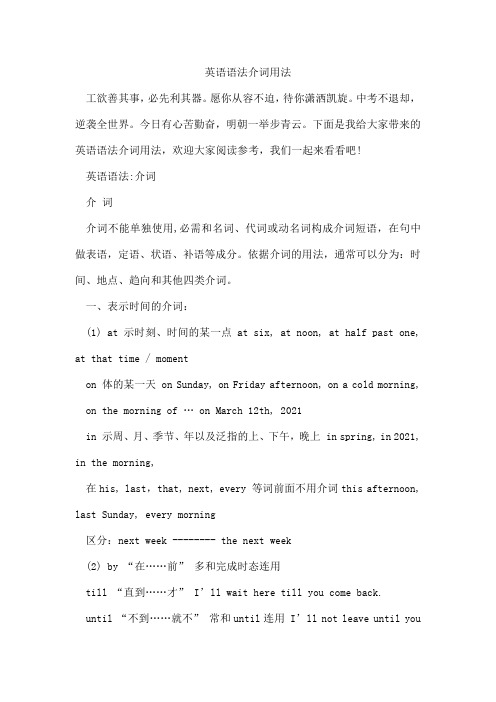
英语语法介词用法工欲善其事,必先利其器。
愿你从容不迫,待你潇洒凯旋。
中考不退却,逆袭全世界。
今日有心苦勤奋,明朝一举步青云。
下面是我给大家带来的英语语法介词用法,欢迎大家阅读参考,我们一起来看看吧!英语语法:介词介词介词不能单独使用,必需和名词、代词或动名词构成介词短语,在句中做表语,定语、状语、补语等成分。
依据介词的用法,通常可以分为:时间、地点、趋向和其他四类介词。
一、表示时间的介词:(1) at 示时刻、时间的某一点 at six, at noon, at half past one, at that time / momenton 体的某一天 on Sunday, on Friday afternoon, on a cold morning, on the morning of … on March 12th, 2021in 示周、月、季节、年以及泛指的上、下午,晚上 in spring, in 2021, in the morning,在his, last,that, next, every 等词前面不用介词this afternoon, last Sunday, every morning区分:next week -------- the next week(2) by “在……前” 多和完成时态连用till “直到……才” I’ll wait here till you come back.until “不到……就不” 常和until连用I’ll not leave until youcome back.(3) in 过……以后, 大多用于将来时 after 多用于过去时(4) since + 过去的一个时间点 (表示时间段, 从……开头到现在) for + 一段时间二、表示场所、方向的介词:(1)at 表示比较详细的地点 at 37 Renming Roadin 表示比较宽敞的地点 in Renming Street(2)above斜上方-------below斜下方 over正上方-------under正下方on 两物体有接触(3) be tween…and..在……和……之间 among在……中间(三者以上)(4) across (从物体表面)跨越, 越过 through (从物体中间)穿透, 穿越(5)in 在……里面(表示静止的位置) into 进入,表示运动方向,常用在表示动作的动词之后, 如 go, come, walk, jump, run 等 into的反义词是out of(6)to 到 (目底地)或方向 towards 指朝着某方向,而不是目的地.He walked towards the beach.三、其它介词1.with (1)在一起; (2)有; (3)用某种工具in 用什么材料或语言,或表示衣着,声调特点等by 用......手段2.Like 象......一样as 作为;根据,象......一样(连词)+ 句子3.for(1)为了(表示目的或缘由) (2)(后面加一段时间)表示时间段英语中考:介词短语[介词短语聚焦]“介词+名词/代词”所构成的短语称为介词短语。
中考英语语法之介词与连词应用
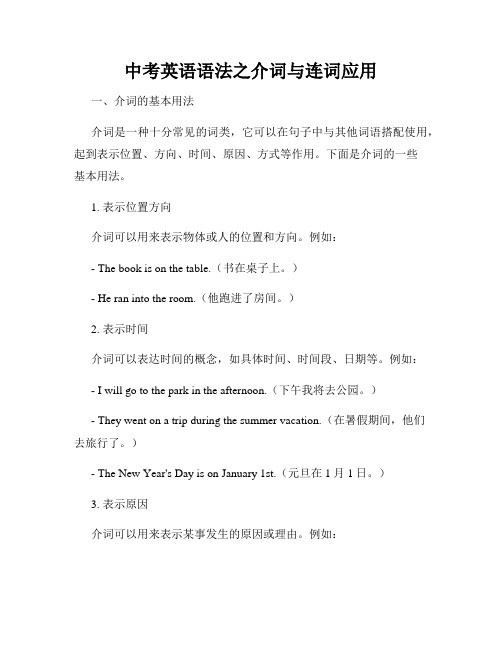
中考英语语法之介词与连词应用一、介词的基本用法介词是一种十分常见的词类,它可以在句子中与其他词语搭配使用,起到表示位置、方向、时间、原因、方式等作用。
下面是介词的一些基本用法。
1. 表示位置方向介词可以用来表示物体或人的位置和方向。
例如:- The book is on the table.(书在桌子上。
)- He ran into the room.(他跑进了房间。
)2. 表示时间介词可以表达时间的概念,如具体时间、时间段、日期等。
例如:- I will go to the park in the afternoon.(下午我将去公园。
)- They went on a trip during the summer vacation.(在暑假期间,他们去旅行了。
)- The New Year's Day is on January 1st.(元旦在1月1日。
)3. 表示原因介词可以用来表示某事发生的原因或理由。
例如:- She failed the exam because of her laziness.(她考试不及格是因为懒惰。
)- He apologized to me for his mistake.(他因为错误向我道歉。
)4. 表示方式介词可以表达某种行为或方式。
例如:- She sings with joy.(她带着喜悦地唱歌。
)- He solved the problem by thinking carefully.(他通过仔细思考解决了这个问题。
)二、连词的基本用法连词是用来连接各种词组、短语或句子的词类,使得语言表达更加流畅和连贯。
下面是连词的一些基本用法。
1. 表示并列关系连词可以把两个或更多的相同类型的词、短语或句子连接起来,表示并列关系。
常见的连词有and、but、or等。
例如:- I like apples and oranges.(我喜欢苹果和橙子。
)- She is smart but lazy.(她聪明但是懒惰。
中考英语介词和介词短语的运用分析

引言:英语介词种类多,用法多样,在中考当中若不能区分介词的含义和用法,极易出现错误。
且英语考试当中,介词的用法为重要考点,包括介词及介词短语,而介词包含方位介词、时间介词,介词短语包括介词加名词、动词加介词、be+形容词+介词、副词加介词等,在英语学习过程中,要从介词分类和用法入手,探讨介词的用法,巩固介词语法知识,为中考做准备。
一、中考英语方位介词的用法分析在中考英语当中,方位介词at,on,in,to等可以表示确定位置,还可以根据介词意思,将其细化为:表示“里外”的介词有between,among,outside,inside;表示“上下”的介词有above,over,below,under等;表示前后的介词有in front of,behind,in the front of;表示“进出”的介词有onto,into,off,out of;表示“向……”“沿着”的介词有to,from,along,towards,up,down;表示“穿越”的介词有over, across,through。
其中表示准确定位的介词用法如下:at后面通常接“小地点”,更侧重于“点”,比如at the park;介词in意为“在……里面”,表示特定范围之内,突出“空间感”,如in the box;介词on表示物体的表面有接触,意为“在……上面”,也可以表示“在左边”“在右边”,on the left或者on the right。
表示精准定位的介词还有特殊用法,当与方位名词进行连用时,in可表示“属于”的意思,on代表“接壤”含义,to代表“不属于”“不接壤”含义。
如:Shanghai is in the east of China.(介词表示所属)Yunnan is on the south of Sichuan.(介词表示接壤)Japan is to the east of China.(介词表示不属于,不接壤)学习方位介词时要注意,in可以表示“在……上”,如“in today’s newspaper”主要指的是“报纸上的内容”,还有短语in the wall代表窗户、洞口或者钉子嵌入墙体内部,in the tree代表后落在树上的事物。
【中考英语语法汇总】介词语法讲解
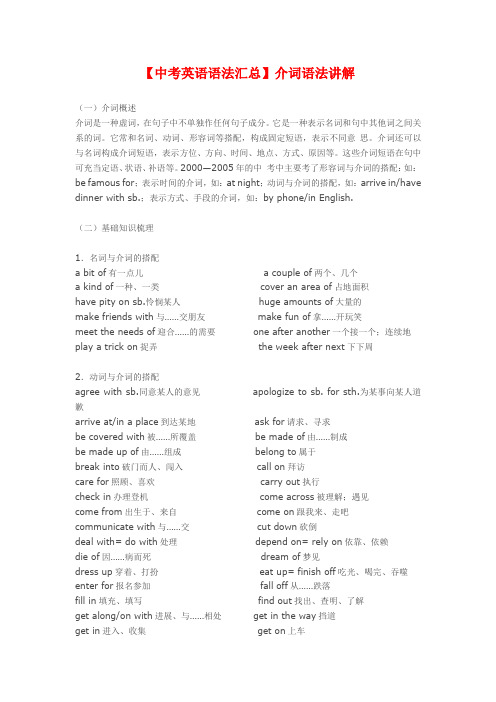
【中考英语语法汇总】介词语法讲解(一)介词概述介词是一种虚词,在句子中不单独作任何句子成分。
它是一种表示名词和句中其他词之间关系的词。
它常和名词、动词、形容词等搭配,构成固定短语,表示不同意思。
介词还可以与名词构成介词短语,表示方位、方向、时间、地点、方式、原因等。
这些介词短语在句中可充当定语、状语、补语等。
2000—2005年的中考中主要考了形容词与介词的搭配:如:be famous for;表示时间的介词,如:at night;动词与介词的搭配,如:arrive in/have dinner with sb.;表示方式、手段的介词,如:by phone/in English.(二)基础知识梳理1.名词与介词的搭配a bit of有一点儿 a couple of两个、几个a kind of一种、一类 cover an area of占地面积have pity on sb.怜悯某人huge amounts of大量的make friends with与……交朋友 make fun of拿……开玩笑meet the needs of迎合……的需要 one after another一个接一个;连续地play a trick on捉弄 the week after next下下周2.动词与介词的搭配agree with sb.同意某人的意见 apologize to sb. for sth.为某事向某人道歉arrive at/in a place到达某地 ask for请求、寻求be covered with被……所覆盖 be made of由……制成be made up of由……组成 belong to属于break into破门而人、闯入 call on拜访care for照顾、喜欢 carry out执行check in办理登机 come across被理解;遇见come from出生于、来自 come on跟我来、走吧communicate with与……交cut down砍倒deal with= do with处理depend on= rely on依靠、依赖die of因……病而死dream of梦见dress up穿着、打扮 eat up= finish off吃光、喝完、吞噬enter for报名参加fall off从……跌落fill in填充、填写 find out找出、查明、了解get along/on with进展、与……相处 get in the way挡道get in进入、收集 get on上车get off下车 get rid of摆脱get ready for为….作准备 get to到达get tired of对……感到厌倦 go in for参加、从事于、酷爱,'^ go ahead先走、向前走;去吧 go for a swim去游泳go on a diet实行节食 go over复习go on with继续做某事 grow up长大、成长hand in上交 hear from收到……的来信hear of听说 help sb. with sth.帮助某人做某事hold on等等(别挂电话)hold up举起hurry off匆忙离开join.n参加、加入keep... from使……不做 keep in touch with与……保持联系keep off阻挡;不让接近 knock over撞倒、撞翻later on过来;后来 laugh at嘲笑learn.., from向……学习 leave for动身去let out放出 line up整队;排成行live on靠……为生look after照顾;照料look at看;观看 look for寻找look forward to期待着 look like看上去像;显得look out of从……朝外看look up查寻;抬头看make out辨认出make up one's mind下决心meet with遭遇 operate on sb.为……动手术pay for付……钱 pick out拾起play with玩弄point at指向;指着point out指出praise sb. for sth.为某事表扬某人prefer... to(比起……来)更喜欢 prepare for准备protect... from保护……免受 pull down推倒put off延期put on穿;戴上;上演put out伸出 put up举起;挂起run after追捕;追踪 run away逃跑search for搜寻;搜查see off为……送行sell out售完 set out/off for出发去……;起程去……set up建立;设立. shake hands with与……握手share with与……分享show off炫耀show sb around带某人参观 shut up住口speed up加快速度stop...from阻止……做take away拿走 take care of照料take charge of负责;管理;take hold of抓住take in吸入 take off脱掉(衣物等);起飞take out取出take part in参加take up开始从事 talk about谈到talk to/with与...谈话 tell... from区别;分辨think of想起;想到 think over仔细考虑throw away扔掉 tie up捆绑try on 试穿turn down(把音量)调低turn into变成 turn off关掉(电灯、电视、收音机等)turn on开,旋开(电灯、电视、收音机等) turn over翻车;翻阅;翻身turn out结果是;证明是 wake up醒来;叫醒wait for等待;等候 write down写下work out算出;制定出经典例题:1.The foreigners arrived __________Shanghai __________ night.A. at…atB. in…atC. in... inD. at... in2. Wushu is becoming more and more popular __________ westerners.A. amongB. betweenC. inD.within3. __________ the help of the teachers, we decorated. Ourclassroom__________lanterns, flowers and pictures yesterday.A. Under... withoutB. Under... amongC. With... withD.With...between4. The cakes __________ the shape of a round moon is called mooncakes.A. likeB. look likeC. asD. likes5.改错:The manager told his secretary that he would be back __________ three-thirty.A. inB. afterC. beforeD. at6. It was clever __________ the boy to work __________ the mathsproblems in less than ten minutes.A. for…outB. of... outC. for...onD. of... on7. My aunt Jane tried her best to reduce her weight ________ 6kg.A.about B.at C.to D.by8. In my opinion, I agree __________ you __________that.A. to… withB. with…toC. with.., withD. with.., on9. I am familiar__________ this school since I have worked here for morethan fifteen years.A. withB. toC. aboutD. of10. Would you please look __________ my baby girl __________ myabsence?A. after…duringB. for…duringC. after… inD. to...in11. Mexico is ________ the south of America.A. inB. toC. onD. of12. The boy ____ the bike is Jackie Hu from Britain.A. byB. onC. inD. with13. Smoking and drinking are not good _______ your health.A. forB. toC. ofD. at14. Can you see the cat hiding __________ the tree?A. onB. underC. overD. in15. The litter bin__________ the corner of the room is a present from mybrother.A. atB. onC. inD. among16. It's fun to see a large number of stars shining in the sky ________ aclear night.A. atB. inC. onD. of1. 【解析】答案是B。
中考英语专题复习之介词

中考英语专题复习之介词【知梳理】一、考介的用法[ 知接 ]分例in, at, on, between, since, for, during, until, till, by, from,表示to, by, before, pastin, at, on, around, before, in front of, between, behind,表示方向beside, near, under, above, below, ,next to, among表示来回的to, towards, round, around, though, across, from⋯to,方向into, out of, off, alongby, to, like, unlike, of, except, about, against, with, but,其余as, without(一)时间介词1.at、in 、on 表示的区(1)at 表示详细的点,常用于表示点及某些中。
如:at Christmas(在圣 );at six o ock(’cl在 6 点 );at night(在夜晚 );at the end of(在⋯⋯束 );at the age of(在⋯⋯);at last(最,最后 )。
(2)in 能够表示从在算起到若干此后,意“在⋯⋯后”,用于一般未来或去未来。
如:Can you finish drawing a good horse in five minutes?你能在 5 分内画一匹漂亮的?(3)on 用于表示确立的,详细某一天或详细某一天的上午、下午、夜晚或一般日等。
如:on December 1st,1994 (在 1994 年 12 月 1 日);on Teachers ’ Day在 (教 )on Monday morning (在礼拜一上午 );on a cold morning (在一个严寒的清晨 );on the night of October 22nd (在 10 月 22 日夜晚 );on Christmas Day (在圣 )。
初三中考英语介词总复习
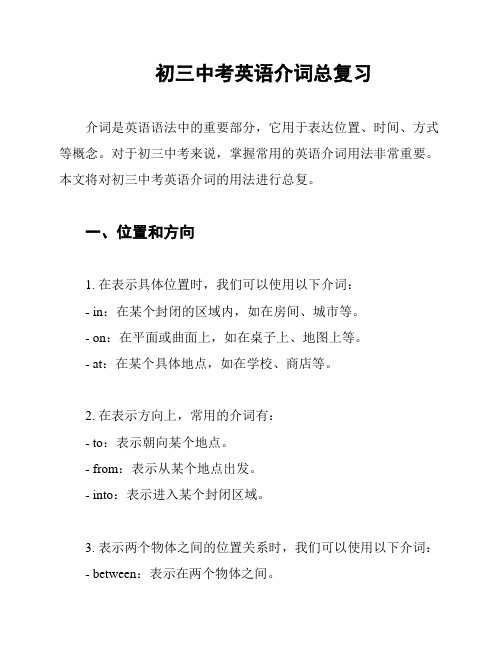
初三中考英语介词总复习介词是英语语法中的重要部分,它用于表达位置、时间、方式等概念。
对于初三中考来说,掌握常用的英语介词用法非常重要。
本文将对初三中考英语介词的用法进行总复。
一、位置和方向1. 在表示具体位置时,我们可以使用以下介词:- in:在某个封闭的区域内,如在房间、城市等。
- on:在平面或曲面上,如在桌子上、地图上等。
- at:在某个具体地点,如在学校、商店等。
2. 在表示方向上,常用的介词有:- to:表示朝向某个地点。
- from:表示从某个地点出发。
- into:表示进入某个封闭区域。
3. 表示两个物体之间的位置关系时,我们可以使用以下介词:- between:表示在两个物体之间。
- among:表示在三个或以上的物体之间。
二、时间1. 表示具体时间时,常用的介词有:- at:表示在具体时刻,如在5点。
- on:表示在某一天或日期,如在星期三、在六月。
2. 表示时间段时,我们可以使用以下介词:- during:表示在整个时间段内。
- for:表示持续的时间。
三、方式1. 表示通过某种方式进行某个动作时,常用的介词有:- by:表示通过某种手段、方法。
- with:表示使用某种工具或手段。
2. 表示伴随状态或情感时,我们可以使用以下介词:- with:表示伴随状态。
- for:表示特定的目的或情感。
四、其他常用介词1. 表示原因或结果时,常用的介词有:- because of:表示因为。
- due to:表示由于。
2. 表示目的时,我们可以使用以下介词:- for:表示为了某个目的。
3. 表示比较时,常用的介词有:- than:表示比较。
这些是初三中考英语介词的一些常见用法,希望同学们能够通过复和实践掌握它们,提高自己的英语水平。
祝各位同学在中考中取得优异的成绩!以上是初三中考英语介词总复的内容,希望对你有所帮助。
> 注意:本文的内容仅供参考,请以教材和老师的指导为准。
- 1、下载文档前请自行甄别文档内容的完整性,平台不提供额外的编辑、内容补充、找答案等附加服务。
- 2、"仅部分预览"的文档,不可在线预览部分如存在完整性等问题,可反馈申请退款(可完整预览的文档不适用该条件!)。
- 3、如文档侵犯您的权益,请联系客服反馈,我们会尽快为您处理(人工客服工作时间:9:00-18:30)。
中考英语介词的用法讲解一、知识框架二、知识点梳理一、定义:介词:是一种用来表示词与词、词与句之间的关系的词,在句中不能单独作句子成分。
二、介词短语的句法作用1、介词短语相当于一个形容词或副词,可用作状语、定语和表语。
如:The man came <down the stairs>.(状)The woman <with a flower on her head> is from the countryside.(定)The teacher is now with the pupils.(表)(老师现在和学生在一起)2、介词短语在句子中的位置:介词短语做状语时,如果表示时间/地点,可以放在句首或句尾。
如果表示方向/方式/伴随/涉及/原因/目的/比较,一般放在句尾;介词短语作表语时放在连系动词之后;介词短语作定语时,只能放在被修饰的名词之后。
如:He wanted to find a good job in Shanghai the next year.(状语)They searched the room for the thief.The letters are for you.(表语)Have you seen a cat with a black head and four white legs?(定语)三、介词用法(一)表时间的介词:1.at通常用于:(表示在某个时刻或者瞬间)at+时间点,节日(泛指圣诞节、新年等整个假期时,要用at)如:at 7:30; at lunch time; at Christmas 在圣诞节期间固定词组搭配:at dawn, at night, at midnight, at noon, at that time, at the moment2. on通常用于:(表示在具体的某一天或者某天的上下午等)on+具体时间(日期,星期几)on October 1st ; on Monday; on a rainy morning; on Teachers’ Dayon Christmas Day 在圣诞节这一天3. in通常用于:(表示在一段时间里)①in+世纪/年/月/季节/早/中/晚in the 20th century, in the late 18th century②特定的年龄段,in his thirties (在他30多岁时)补充1:表示“在一段时间之后”,句子常用一般将来时。
e.g. He will come back in an hour.他一小时后会回来。
表示“在一段时间之内”,句子常用一般现在时或一般过去时。
e.g.There as once an artist. He could draw a beautiful horse in five minutes.注意:在含有this、that 、these、those、next、last 、today、tomorrow、yesterday 等词或词组前不用介词。
4.since和for两者都表示一段时间,可以用于完成时;since + 时间段+ ago/+ 时间点/一般过去时句子,for +时间段。
e.g. Uncle Li has worked in this factory since 1970.Uncle Li has worked in this factory for over 30 years.* since 和for 可以进行句型转换:He has been in this school since nine years ago.= He has been in this school for nine years.补充:介词for:1.为了My mother bought a present for me.2. 对于It’s difficult for him to finish the task.3. 因为I am sorry for his misfortune.5.until和byby意为“不迟于,到…时(为止)”,其前多用结束性动词。
e.g.We can finish the work by the end of this month.until用于肯定句中,意为“直到……为止”,用于否定句中“not.....until.....”意为“直到……才”.e.g.she didn't come back home until September.6. 其他常见的时间介词after在…以后after 3 daysbefore在…以前 3 days beforepast过了…(时) 20 past 8 (8点20分)to到(下一时刻) 20 to 8 (7点40)through(out) 贯穿…(期间) through(out) the yearfrom从…(时)起from now onby到…为止till直到…时until直到…时ever since从那时起至今(二)表地点的介词1.in和atat表示较小的地点:at the bus stop ,at homein表示较大的地方:in China ,in the world注意:①门牌号码用at。
e g:Mary lives at 33 Forest Road. 玛丽住在森林路33号。
②街名要用in。
e g:Jane lives in Albert street. 珍妮住在艾尔泊特大街。
③谈到楼层时用on。
e g:Tom lives in a flat on the fourth floor. 汤姆住在四楼的一套房间里。
(三)表方位的介词1.on、over和aboveon意为“在……的上面”;表示两物体接触。
over意为“在……(垂直)的正上方”;反义词:underabove意为“在……(不一定垂直)的上方”,高于;反义词:below注意:*其中on 还有“关于”的意思。
over 也有“在....期间”的意思e.g. a report on school uniform/over the breakfast2.across和through 穿过、越过across指“从……表面穿过”或沿某一条线的方向而进行的动作。
through指“从……内部穿过”;在立体空间中“穿过”。
e g:There were so many cars . She had to walk across the street quickly.He swam across the river.e g:At last he walked through the forest and saw the village.3.in front of 和in the front ofin front of 表“在…之前”,外部e.g. There are some trees in front of the classroom.in the front of表“在……的前部”,内部e.g. Our teacher usually sits in the front of the classroom.4.地理位置:in、to和on①in表示在某一地区的某方位,属于某范围—— A in Be.g. Beijing is in the north of China.②to表示某一地区之外的某方位,不属于该范围—— A to Be.g. Japan is to the east of China.③on表示两地相接壤—— A on Be.g. Korea is on the east of China.介词用图示的方法归纳列举如下:(四)表示方式的介词1.by、in和on——表交通①by + 交通工具,意为“乘坐……”。
e.g.海:be ship /boat / sea/陆:by bus / car /train / bike /taxi/空:by air / plane / spaceship②on / in + 限定词+ 交通工具,意为“乘坐……”。
在开放或半封闭型工具前用on ;/在封闭型工具前用in。
e.g. He goes to work on the bike / in his car.on foot为固定短语,意为“步行”。
* 小口诀:介词用来表交通,常把by, in, on来用;限定、复数用in / on,by要直通海陆空;骑马、骑车惯用on,小轿车前in才通。
2.in、with、through和by——“用”①in主要表示“用语言、笔墨、声音等”;②with表示“用具体有形的东西”;③through通过具体过程,途径,手段,中介;④by表示“用……手段或方式”,后+动名词。
e.g. Can you sing this song in English?I write my homework with a pen.I learned it through a friend.The girl made money by selling flowers.补充1:in穿戴I am in a red dress.补充2:with与......“一起,和,用”,做伴随状语。
反义词:without 没有e.g. I go to the park with my mother./You can write with a pen.She is a woman with a three-year-old baby.补充3:* within 在......之内;不超过……的范围e.g Within 3 days, he will arrive here.四、易混介词辨析1.between 和among——之间between常指“在……两者之间”;among用于指“在……三者或三者以上的人或物之间”。
。
